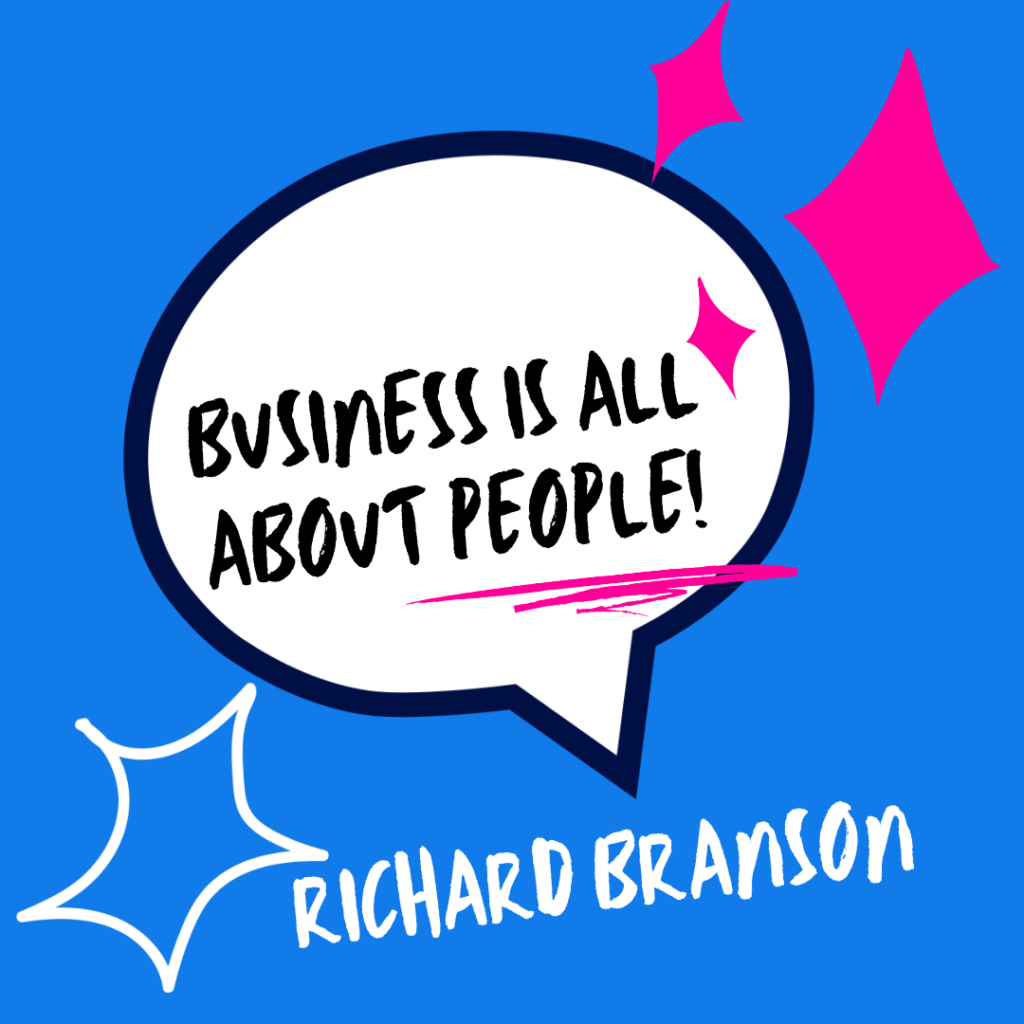If you can’t explain it simply, you don’t know it well enough.
– Albert Einstein –
A couple of weeks ago, I stumbled upon Susanne Cornelius‘ (CEO Douglas Brands) post in which she articulated her guiding principle ‚People First!‘, which aims to benefit both the employer and the employee equally.

This led me to wonder whether people truly understand what ‚People First‘ really means. As a principle that is often romanticized by the media, it can give the impression that it’s all about people without considering the needs of the business. However, this is far from the truth. Businesses are not social institutions whose sole purpose is to take care of their employees no matter what. There are certain expectations in place – employers hire employees with the expectation that they will add value to the company, and employees have expectations towards their employers as well.
‚People First‘ is based on the fact that a company’s success is entirely dependent on its PEOPLE. Richard Branson once said, „Business is all about people!“.
👍 100% true
Putting People First implies that a leader puts in maximum effort to prioritize their employees and their needs in order to help them reach their full potential, which ultimately contributes to the company’s success.
Although it may seem equally focused on obtaining the best visions, ideas, and skills as any other leadership style, employees still benefit from this approach greatly. Why?
In a truly People First environment, the leadership team cares deeply about their employees and values teamwork, genuine connections, and trust. This type of environment encourages creativity, provides clear goals for direction, and leaders listen to the needs of their employees. The result is a healthy workplace culture and a great place to work.
There are misunderstandings around ‚People First‘
✦Leaders who solely focus on people without considering the business objectives adequately may create an enjoyable environment initially, but this approach may eventually jeopardize the company and therefore, its employees
✦Self-promoting managers may use „People First“ to improve their image, but they may not genuinely care about people. If they keep promoting „People First“ and you keep doubting their sincerity, it’s a red flag.
Leaders who truly embody ‚People First‘ don’t sugarcoat reality, they align expectations with their team and invest in their employees‘ needs, all while keeping the business objectives in mind. But the key difference lies in their intentions, which come from a good heart. They strive to understand, improve, and empower their team, raising them to new heights without exhausting anyone on the way.
You will see loyalty, people enjoying their work, motivation, and commitment. As a result, business success follows, If you don’t see this, there is no real „People First“.
If a company has difficulty with culture, digital transformation or change in general, it might want to revisit its guiding principles.
———————-
———————-
DE
People First‘, denn wer braucht schon Profit, wenn man glückliche Mitarbeiter hat, nicht wahr?
Vor ein paar Wochen bin ich auf den Beitrag von Susanne Cornelius (CEO Douglas Brands) gestoßen, in dem sie ihr Leitprinzip „People First!“ beschreibt. Ein Leitprinzip, das sowohl dem Arbeitgeber als auch dem Arbeitnehmer gleichermaßen zugute kommen soll.
Was mich zu der Frage brachte, ob alle wirklich verstehen was „People First“ bedeutet. Dieser Leitsatz wird nämlich in den Medien oft romantisch verklärt, so dass der Eindruck entstehen kann, es ginge nur um den Menschen, ohne die Unternehmensbedürfnisse zu berücksichtigen. Dies entspricht jedoch bei weitem nicht der Wahrheit. Unternehmen sind keine sozialen Einrichtungen, deren einziger Zweck es ist, sich ohne Wenn und Aber um ihre Mitarbeiter zu kümmern. Es gibt Erwartungen! Arbeitgeber stellen Mitarbeiter in der Erwartung ein, dass sie einen Mehrwert für das Unternehmen schaffen, und auch die Mitarbeiter haben Erwartungen an ihren Arbeitgeber.
„People First“ basiert auf der Tatsache, dass der Erfolg eines Unternehmens vollständig von den Menschen im Unternehmen abhängt. Richard Branson sagte einmal: „Business is all about people!“
👍 100% Zustimmung.
Den Menschen an erste Stelle zu stellen bedeutet, dass eine Führungskraft maximale Anstrengungen unternimmt, um ihre Mitarbeiter und deren Bedürfnisse am höchsten zu priorisieren, damit sie ihr volles Potenzial ausschöpfen können, was letztendlich dem Erfolg des Unternehmens dient. Auch wenn es den Anschein haben mag, dass dieser Führungsstil genauso auf die besten Visionen, Ideen und Fähigkeiten ausgerichtet ist wie jeder andere, profitieren die Mitarbeiter dennoch in hohem Maße von diesem Ansatz. Und warum?
In einem Umfeld, in dem der Mensch im Mittelpunkt steht, ist dem Führungsteam viel an seinen Mitarbeitern gelegen, es legt Wert auf Teamarbeit, echte zwischenmenschliche Beziehungen und Vertrauen. In einem solchen Umfeld wird Kreativität gefördert, es werden klare richtungsweisende Ziele vorgegeben und Führungskräfte haben ein offenes Ohr für die Bedürfnisse ihrer Mitarbeiter. Das Ergebnis ist eine gesunde Arbeitsplatzkultur und ein toller Arbeitsplatz.
Es gibt einige Missverständnisse in Bezug auf ‚People First‘
✦ Führungskräfte, die sich ausschließlich auf die Menschen konzentrieren, ohne die Unternehmensziele angemessen zu berücksichtigen, mögen anfangs ein angenehmes Umfeld schaffen, doch kann dieser Ansatz letztendlich das Unternehmen und damit seine Mitarbeiter gefährden
✦ Selbstdarstellerische Manager mögen „People First“ verwenden, um ihr Image zu verbessern, während ihnen die Menschen egal sind. Während sie „People First“ vermarkten und Du an der Aufrichtigkeit zweifelst, ist das ein Warnsignal.
Führungskräfte, die „People First“ wirklich verkörpern, beschönigen die Realität nicht, sie stimmen die Erwartungen mit ihrem Team ab und investieren in die Bedürfnisse ihrer Teams, ohne dabei die Unternehmensziele aus den Augen zu verlieren. Der entscheidende Unterschied liegt jedoch in ihren Absichten, die aus gutem Herzen kommen. Sie sind bestrebt, ihr Team zu verstehen, zu verbessern und zu befähigen und es zu neuen Höchstleistungen zu bringen, ohne jemanden dabei zu überfordern. Man wird Loyalität, Freude an der Arbeit, Motivation und Engagement beobachten können. Wenn das nicht zu sehen ist, dann gibt es offensichtlich kein echtes „People First“.
Sollte ein Unternehmen Schwierigkeiten mit der Kultur, der digitalen Transformation oder dem Wandel im Allgemeinen haben, sollte es vielleicht seine Leitprinzipien überdenken.